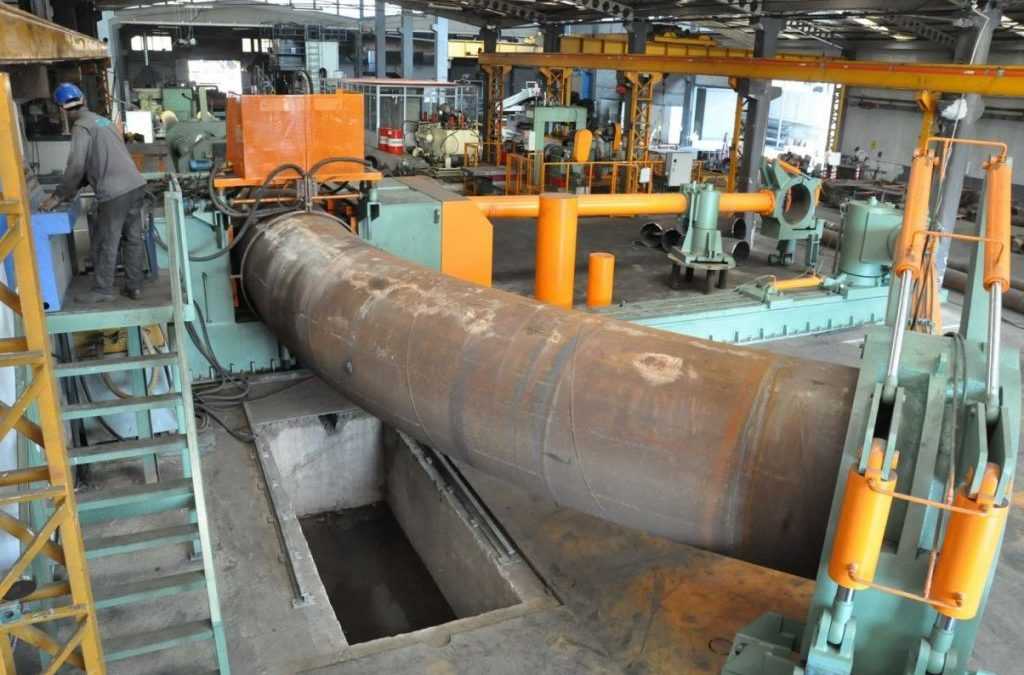The term “hot bending” refers to a procedure in which a curve is produced by applying a load while the temperature is raised. The real benefit of hot bending steel, also known as heat-assisted bending, is that the material yield strength is decreased from the value at room temperature. As a result, the machine that bends hot closed die forging products must bend the material with less force. After applying heat to the member, a bending pressure is applied to the member by a flame, the heating of the member in a furnace, or an induction coil.
It may bend the component around predetermined shapes, but in most cases, the bending force is provided by using one of the bending techniques covered in the preceding section. Heat may be applied to HSS members from either the outside or the inside. In the process of cambering beams by gag pressing, heat is usually only used in cases when the beam strength exceeds the machine’s capacity.
What Is Hot Bending Steel?
A method of bending pipes that is both precisely regulated and very effective is called induction turning. Local heating is accomplished during the induced bending process by using high frequency generated electrical power. A hot bending steel machine can effectively bend structural forms such as channels and W&H sections, in addition to pipes and tubes.
The process of bending metal using induction may alternatively be referred to as “hot bending,” “incremental bending,” or “high-frequency bending.” Induction bending is the most desirable alternative when working with larger pipe diameters or when the technologies available for cold bending are restricted. An induction coil is wrapped around the pipe that will be bent, and the pipe’s circumference is heated to a temperature between 850 and 1100 degrees Celsius since it is hot closed die forging Products.
Hot Bending Process
The following steps are performed for hot bending of pipes or pipeline systems:
- The hydraulically bent pipeline is secured in place by the machine bed’s clamps.
- Heating and cooling coils that are powered by induction are fastened all the way around the pipe. Altering the induction coil in three different planes allows for more even heating to be produced.
- By changing the radius arm and the front clamp, it is possible to customize the bent radius. Only one pointer is necessary to show the precise degree of rotation.
- On the pipe are indications of the arc’s length. It is possible for the line to move slowly while bending forces are applied using an arrangement of arms with a set radius.
- Verification is performed on the hydraulic pressure, water level, and switch positions just before the beginning of the induction bending process.
- After reaching the temperature range, the pipe is advanced gradually at a pace ranging from 10 to 40 millimeters per minute (mm/min). The procedure is finished when both the required bend angle and the predetermined arc length have been obtained.
- The portion of the heated pipe material immediately beyond the induction coil is cooled by a water spray that is applied to the pipe’s exterior surface.
- After that, the result of the induction bend is removed, examined, and finally measured for tolerance.
- The post-bend heat treatments that are used for induction bends are the last step in the process. These treatments are used for a variety of reasons, including stress release and normalization.
Induction bends are made using standard bend angles (e.g., 45°, 90°, etc.). They may, however, be custom-made to certain bend angles based on demand. Compound out-of-plane curves are also feasible in a single pipe junction. Bend radius in induction bending is a function of nominal pipe diameters (D), such as 5D, 30D, and 60D bends.
Hot Bending Steel Advantages
The following are the primary benefits of induction bending:
- Cost-effectiveness. Explicit material is less expensive than standard components (such as elbows), and bends may be made quicker than standard components.
- More significant radius induction bends may often replace elbows, lowering friction, wear, and pump capacity.
- The number of welds in a system is reduced via induction bending.
- In the tangents, there are no welds at the essential spots.
- Less non-destructive testing means lower costs.
- Induction bends are more potent than homogeneous wall thickness elbows.
- The number of elbows and conventional bends available might be drastically decreased.
- Straight pipe is more widely accessible than elbows, which shortens the time to market.
Hot bending steel mainly refers to several methods of induction bending. Induction bending is a very successful method of pipe bending because it is rapid, accurate, and error-free. The induction bending procedure involves heating a specific pipe location so that it may turn quickly. It does not need any filler material, and the bending results in minor deformation. Because of its energy efficiency, many induction benders have chosen this bending form.
Bending takes very little time when the heating procedure is completed. The disadvantages of hot bending include the need for the material to cool after bending, which increases the time required on each pipe, and the devices being more costly than cold bending appliances.
Categories
Recent Posts
Advertisement


